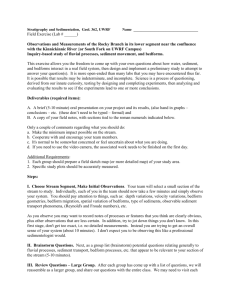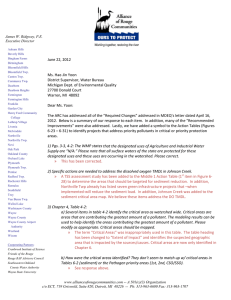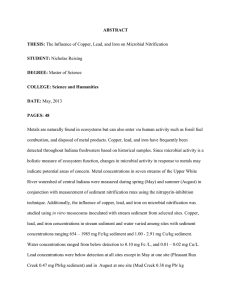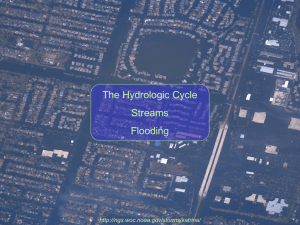Marc Ribaudo Lag Times Briefing
advertisement
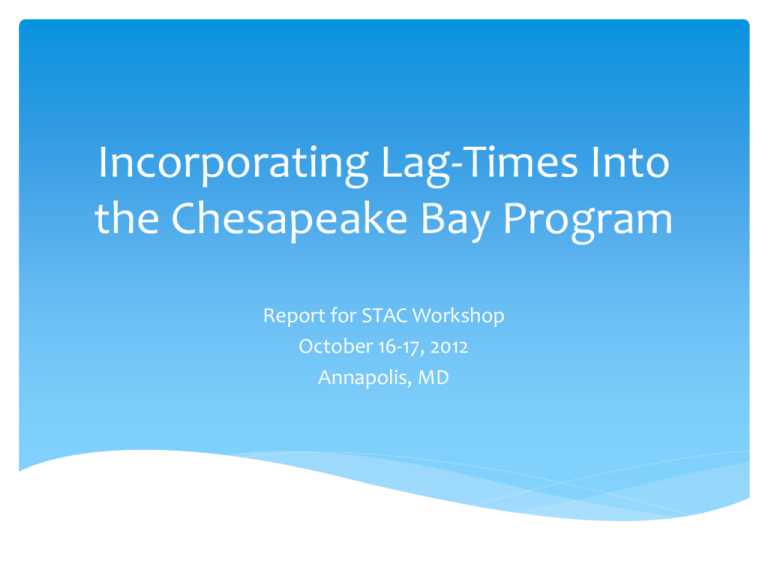
Incorporating Lag-Times Into the Chesapeake Bay Program Report for STAC Workshop October 16-17, 2012 Annapolis, MD Steering Committee Bob Hirsch, chair Jack Meisinger Marc Ribaudo Claire Welty Weixing Zhu Kevin Sellner Russ Brinsfield Don Weller Kurt Gottschalk David Sample Natalie Gardner Matt Ellis Gene Yagow Context of the Workshop Draft Recommendations Expand our conceptual modeling framework to encompass interactions between floodplains, stream channels, and sediment storages in a manner that enables comprehensive sediment budgeting. Improve the accounting of sediment and attached nutrient storages either within the CBWM (lower order streams, stream channel erosion, groundwater dynamics, and reservoir dynamics), and/or through the use of supplemental models. Recommendations (cont.) Comprehensive local inventory of all agricultural and urban BMPs, including performance characteristics. Expedite data sharing agreements, account for previously unaccounted for practices, and standardize local accounting methods and procedures. Expand site-specific data collection efforts to include particle size distribution and soil P in the top few cm of soil. Design new monitoring efforts to explicitly evaluate hypotheses needed to guide restoration, BMP implementation, and land planning in a holistic manner. Expand regional research efforts to include inflow-outflow monitoring of major reservoirs and delineation of provincespecific groundwater flow path delivery mechanisms. Recommendations (cont.) In order to mitigate the effects of lag-times, existing trading programs should be revised to incorporate forward markets to efficiently allocate reductions over time. Additional ecosystem benefits that are delivered more quickly need to be highlighted to foster public support for the program. Information about lag-times can be used to inform the adaptive management process, to educate the public about setting realistic restoration expectations, and to assist local managers in more appropriate selection of control measures that will produce the desired short-term and long-term effects. Develop General Statements about Lag-Time for the Public Prepare a scenario(s) that contrast current CBWM output with and without lag times for hydrology, BMP maturation, and sediment storage to inform the public when the implemented practices will produce the detectable improvements in WQ that we expect. Simulation of BMP implementation requires the use of best professional judgment which includes a degree of uncertainty. Additionally, real-time changes in flow, major weather events, and politics affect the expected changes in WQ, so that adaptive management is key in accommodating lag-time during implementation. Example of Management Practice, Structure, or Upgrade Process Time for Practice to be Installed and for Effect to reach Water Body (Component 3 and 4 of Fig. 1) Nitrogen (N) Phosphorus (P) Sediment Short Short Short Grass Buffers Medium Short Short Riparian Forest Medium Medium Medium Grass Cover Crops Long Long Long Conservation Tillage Long Long Long Stream Bank Stabilization Short Short Short Agriculture Nutrient Management Long Medium NA Soil Conservation Plan Long Long Long Urban Nutrient Management Long Medium NA Urban Sediment Pond Short Short Short Treatment Plant N Upgrade Short NA NA Treatment Plant P Upgrade NA Short NA Non- Point Source Livestock Exclusion Point Source Lag Time class: Short = 1-3 yrs, storm flow near stream for P and sediment; Medium = 2-10 yrs, longer installation time or moderate distance from stream; Long = 7-50 yrs, base flow transport of soluble nutrients or located in upper half of watershed; NA = not applicable Effect on N or P or Sediment: Green = major effect ; Blue = secondary effect ; Red = minor effect Implications Since lag-times are associated with most agricultural BMPs, modeled results will not be consistent with WQ observations, and WQ standards and TMDL reduction goals will not be met as soon as the CBWM projects. If lag-times are accounted for, and point source WQ permits must still be met annually, the economics driving the decision of point source permit holders, about whether to participate in nutrient trading or to install advanced treatment technology, will favor the advanced treatment technology.






